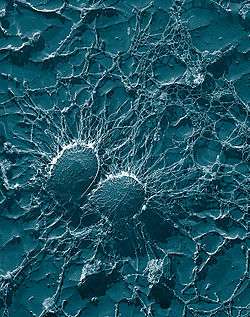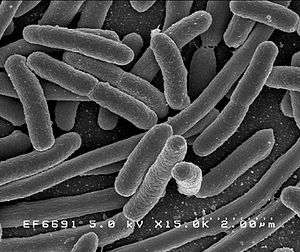List of human microbiota
This article lists some of the species recognized as belonging to the human microbiota.
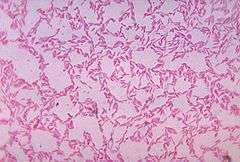
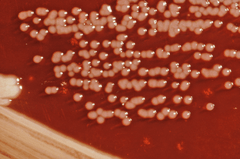
Whole-body distributed
Natural cavities
Skin
- Acinetobacter spp
- Bacillus spp
- Candida albicans
- Corynebacterium spp
- Corynebacterium parvum
- Cutibacterium acnes
- Demodex folliculorum
- Enterobacter cloacae
- Epidermophyton floccosum
- Micrococcus spp
- Micrococcus luteus
- Mycobacterium spp
- Neisseria spp
- Peptostreptococcus spp
- Malassezia ovale
- Propionibacterium spp
- Pseudomonas aeruginosa
- Sarcina spp
- Staphylococcus aureus
- Staphylococcus epidermidis
- Staphylococcus haemolyticus
- Streptococcus viridans
- Trichophyton spp
Candida parapsilosis
Hair follicles
External ear
Mucous membranes
Eye
- Chlamydophila pneumoniae
- Haemophilus aegyptius
- Haemophilus influenzae
- Moraxella spp
- Neisseria spp
- Staphylococcus aureus
- Staphylococcus epidermidis
- Streptococcus viridians
Gastrointestinal tract
| Binomial name | Location |
|---|---|
| Achromobacter spp | Large intestine, small intestine (Ileon) |
| Acidaminococcus fermentans | Large intestine |
| Acinetobacter calcoaceticus | Large intestine |
| Actinomyces spp | Mouth, small and large intestine |
| Actinomyces viscosus | Mouth |
| Actinomyces naeslundii | Mouth |
| Aeromonas spp | Large intestine, small intestine (Ileon) |
| Aggregatibacter actinomycetemcomitans | Mouth |
| Anaerobiospirillum spp | Feces |
| Alcaligenes faecalis | Large intestine, small intestine (Ileon) |
| Arachnia propionica | Mouth |
| Bacillus spp | Large intestine |
| Bacteroides spp | Mouth, GI tract |
| Bacteroides gingivalis | Mouth |
| Bacteroides fragilis | General distribution |
| Bacteroides intermedius | Mouth |
| Bacteroides melaninogenicus | Mouth, feces |
| Bacteroides pneumosintes | Pharynx |
| Bacterionema matruchotii
(Corynebacterium matruchotii, new combination 1983 IJSB 33:438) |
Gingiva |
| Bifidobacterium spp | Large intestine, feces |
| Buchnera aphidicola | Mouth |
| Butyriviberio fibrosolvens | Large intestine |
| Campylobacter spp | Large intestine |
| Campylobacter coli | General distribution |
| Campylobacter sputorum | Mouth |
| Campylobacter upsaliensis | Mouth |
| Candida albicans | Mouth |
| Capnocytophaga spp | Mouth |
| Clostridium spp | Large intestine, small intestine (Ileon) |
| Citrobacter freundii | Sputum |
| Clostridium difficile | Large intestine |
| Clostridium sordellii | Stomach, small intestine, large intestine, rectus, anus channel |
| Corynebacterium spp | Mouth |
| Cutibacterium acnes | General distribution |
| Eikenella corrodens | General distribution, mouth |
| Enterobacter cloacae | General distribution |
| Enterococcus spp | Mouth, GI tract |
| Enterococcus faecalis | General distribution |
| Enterococcus faecium | General distribution |
| Escherichia coli | General distribution |
| Eubacterium spp | Mouth, GI tract |
| Flavobacterium spp | Large intestine, small intestine (Ileon) |
| Fusobacterium spp | Mouth, GI tract |
| Fusobacterium nucleatum | Mouth |
| Gordonia Bacterium spp | Sputum |
| Haemophilus parainfluenzae | Mouth |
| Haemophilus paraphrophilus | Mouth |
| Lactobacillus spp | Mouth, Saliva, GI tract (known probiotic) |
| Leptotrichia buccalis | Mouth |
| Methanobrevibacter smithii | Intestines |
| Morganella morganii | Feces |
| Mycobacteria spp | Large intestine, small intestine (Ileon) |
| Mycoplasma spp | Large intestine, small intestine (Ileon) |
| Micrococcus spp | Mouth |
| Mycoplasma spp | Mouth |
| Mycobacterium chelonae | Sputum |
| Neisseria spp | Mouth |
| Neisseria sicca | Saliva, sputum |
| Peptococcus spp | Mouth, large intestine |
| Peptostreptococcus spp | Mouth, GI tract |
| Plesiomonas shigelloides | General distribution |
| Porphyromonas gingivalis | Mouth |
| Propionibacterium spp | Large intestine |
| Providencia spp | Feces |
| Pseudomonas aeruginosa | Large intestine, small intestine (Ileon) |
| Ruminococcus bromii | Large intestine |
| Rothia dentocariosa | Mouth |
| Ruminococcus spp | Cecum, large intestine |
| Sarcina spp | Large intestine |
| Staphylococcus aureus | Mouth, large intestine, small intestine (Ileon) |
| Staphylococcus epidermidis | Mouth |
| Streptococcus anginosus | General distribution |
| Streptococcus mutans | Teeth: Dental plaque |
| Streptococcus oralis | Teeth: Dental plaque |
| Streptococcus pneumoniae | Nasopharynx |
| Streptococcus sobrinus | Teeth: Dental plaque |
| Streptococcus viridans | Mouth, large intestine, small intestine (Ileon) |
| Torulopsis glabrata | Mouth |
| Treponema denticola | Mouth |
| Treponema refringens | Mouth |
| Veillonella spp | Mouth, large Intestine |
| Vibrio spp | Large intestine, Small intestine (Ileon) |
| Vibrio sputorum | Mouth |
| Wolinella succinogenes | Mouth |
| Yersinia enterocolitica | Large intestine |
Respiratory tract
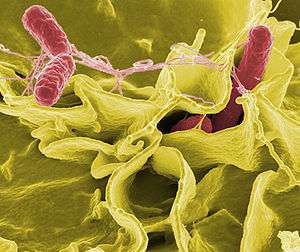
Urogenital tract
| Binomial name | Location |
|---|---|
| Acinetobacter spp | Anterior urethra |
| Bacteroides spp | External genitalia |
| Candida albicans | Anterior urethra, external genitalia, |
| Corynebacterium spp | Anterior urethra, external genitalia, |
| Enterobacteriaceae | Anterior urethra, external genitalia, |
| Streptococcus viridans | Anterior urethra, external genitalia, |
| Eikenella corrodens | General distribution |
| Streptococcus anginosus | General distribution |
| Staphylococcus aureus | Perineum |
Vagina
The vaginal microbiota in pregnancy varies markedly during the entire time of gestation. The species and diversity of the microorganisms may be related to the various levels of hormones during pregnancy.[1]
Placenta
Uterus
The healthy uterine microbiome has been identified and over 278 genera have been sequenced.[2]
Ovarian follicle
The ovarian follicle microbiome has been studied using standard culturing techniques. It has been associated with the outcomes of assisted reproductive technologies and birth outcomes. Positive outcomes are related to the presence of Lactobacilli spp while the presence of Propionibacterium and Actinomyces were related to negative outcomes. Also, the microbiome can vary from one ovary to the other. Studies are ongoing in the further identification of those bacteria present.[2]
Male reproductive tract
The microbiome present in seminal fluid has been evaluated. Using traditional culturing techniques the microbiome differs between men who have acute prostatitis and those who have chronic prostatitis. Identification of the seminal fluid microbiome has become one of the diagnostic tools used in treating infertility in men that do not display symptoms of infection or disease. The taxa Pseudomonas, Lactobacillus, and Prevotella display a negative effect on the quality of sperm. The presence of Lactobacillus spp in semen samples is associated with a very high normal sperm count.[2]
References
- Fox, Chelsea; Eichelberger, Kacey (2015). "Maternal microbiome and pregnancy outcomes". Fertility and Sterility. 104 (6): 1358–1363. doi:10.1016/j.fertnstert.2015.09.037. ISSN 0015-0282. PMID 26493119; Access provided by the University of Pittsburgh
- Franasiak, Jason M.; Scott, Richard T. (2015). "Reproductive tract microbiome in assisted reproductive technologies". Fertility and Sterility. 104 (6): 1364–1371. doi:10.1016/j.fertnstert.2015.10.012. ISSN 0015-0282. PMID 26597628; Access provided by the University of Pittsburgh
External links
| Wikispecies has information related to Microbiota |
